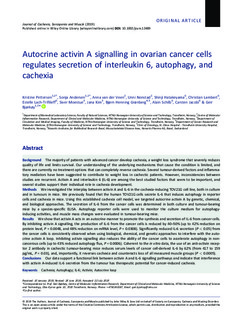| dc.contributor.author | Pettersen, Kristine | |
| dc.contributor.author | Andersen, Sonja Benedikte | |
| dc.contributor.author | van der Veen, Anna | |
| dc.contributor.author | Nonstad, Unni | |
| dc.contributor.author | Hatakeyema, Shinji | |
| dc.contributor.author | Lambert, Christian | |
| dc.contributor.author | Lach-Trifilieff, Estelle | |
| dc.contributor.author | Moestue, Siver Andreas | |
| dc.contributor.author | Kim, Jana | |
| dc.contributor.author | Grønberg, Bjørn Henning | |
| dc.contributor.author | Schilb, Alain | |
| dc.contributor.author | Jacobi, Carsten | |
| dc.contributor.author | Bjørkøy, Geir | |
| dc.date.accessioned | 2019-09-26T08:11:43Z | |
| dc.date.available | 2019-09-26T08:11:43Z | |
| dc.date.created | 2019-08-22T10:00:26Z | |
| dc.date.issued | 2019 | |
| dc.identifier.citation | Journal of Cachexia, Sarcopenia and Muscle. 2019, . | nb_NO |
| dc.identifier.issn | 2190-5991 | |
| dc.identifier.uri | http://hdl.handle.net/11250/2618885 | |
| dc.description.abstract | Background
The majority of patients with advanced cancer develop cachexia, a weight loss syndrome that severely reduces quality of life and limits survival. Our understanding of the underlying mechanisms that cause the condition is limited, and there are currently no treatment options that can completely reverse cachexia. Several tumour‐derived factors and inflammatory mediators have been suggested to contribute to weight loss in cachectic patients. However, inconsistencies between studies are recurrent. Activin A and interleukin 6 (IL‐6) are among the best studied factors that seem to be important, and several studies support their individual role in cachexia development.
Methods
We investigated the interplay between activin A and IL‐6 in the cachexia‐inducing TOV21G cell line, both in culture and in tumours in mice. We previously found that the human TOV21G cells secrete IL‐6 that induces autophagy in reporter cells and cachexia in mice. Using this established cachexia cell model, we targeted autocrine activin A by genetic, chemical, and biological approaches. The secretion of IL‐6 from the cancer cells was determined in both culture and tumour‐bearing mice by a species‐specific ELISA. Autophagy reporter cells were used to monitor the culture medium for autophagy‐inducing activities, and muscle mass changes were evaluated in tumour‐bearing mice.
Results
We show that activin A acts in an autocrine manner to promote the synthesis and secretion of IL‐6 from cancer cells. By inhibiting activin A signalling, the production of IL‐6 from the cancer cells is reduced by 40–50% (up to 42% reduction on protein level, P = 0.0048, and 48% reduction on mRNA level, P = 0.0308). Significantly reduced IL‐6 secretion (P < 0.05) from the cancer cells is consistently observed when using biological, chemical, and genetic approaches to interfere with the autocrine activin A loop. Inhibiting activin signalling also reduces the ability of the cancer cells to accelerate autophagy in non‐cancerous cells (up to 43% reduced autophagy flux, P = 0.0006). Coherent to the in vitro data, the use of an anti‐activin receptor 2 antibody in cachectic tumour‐bearing mice reduces serum levels of cancer cell‐derived IL‐6 by 62% (from 417 to 159 pg/mL, P = 0.03), and, importantly, it reverses cachexia and counteracts loss of all measured muscle groups (P < 0.0005).
Conclusions
Our data support a functional link between activin A and IL‐6 signalling pathways and indicate that interference with activin A‐induced IL‐6 secretion from the tumour has therapeutic potential for cancer‐induced cachexia. | nb_NO |
| dc.language.iso | eng | nb_NO |
| dc.publisher | Wiley | nb_NO |
| dc.rights | Navngivelse 4.0 Internasjonal | * |
| dc.rights.uri | http://creativecommons.org/licenses/by/4.0/deed.no | * |
| dc.title | Autocrine activin A signalling in ovarian cancer cells regulates secretion of interleukin 6, autophagy, and cachexia | nb_NO |
| dc.type | Journal article | nb_NO |
| dc.type | Peer reviewed | nb_NO |
| dc.description.version | publishedVersion | nb_NO |
| dc.source.pagenumber | 13 | nb_NO |
| dc.source.journal | Journal of Cachexia, Sarcopenia and Muscle | nb_NO |
| dc.identifier.doi | 10.1002/jcsm.12489 | |
| dc.identifier.cristin | 1717909 | |
| dc.description.localcode | © 2019 The Authors. Journal of Cachexia, Sarcopenia and Muscle published by John Wiley & Sons Ltd on behalf of Society on Sarcopenia, Cachexia and Wasting Disorders Journal of Cachexia, Sarcopenia and Muscle (2019) Published online in Wiley Online Library (wileyonlinelibrary.com) DOI: 10.1002/jcsm.12489 This is an open access article under the terms of the Creative Commons Attribution License, which permits use, distribution and reproduction in any medium, provided the original work is properly cited. | nb_NO |
| cristin.unitcode | 194,65,15,0 | |
| cristin.unitcode | 194,65,25,0 | |
| cristin.unitcode | 1920,12,0,0 | |
| cristin.unitcode | 194,66,40,0 | |
| cristin.unitname | Institutt for klinisk og molekylær medisin | |
| cristin.unitname | Institutt for sirkulasjon og bildediagnostikk | |
| cristin.unitname | Kreftklinikken | |
| cristin.unitname | Institutt for bioingeniørfag | |
| cristin.ispublished | true | |
| cristin.fulltext | original | |
| cristin.qualitycode | 1 | |

